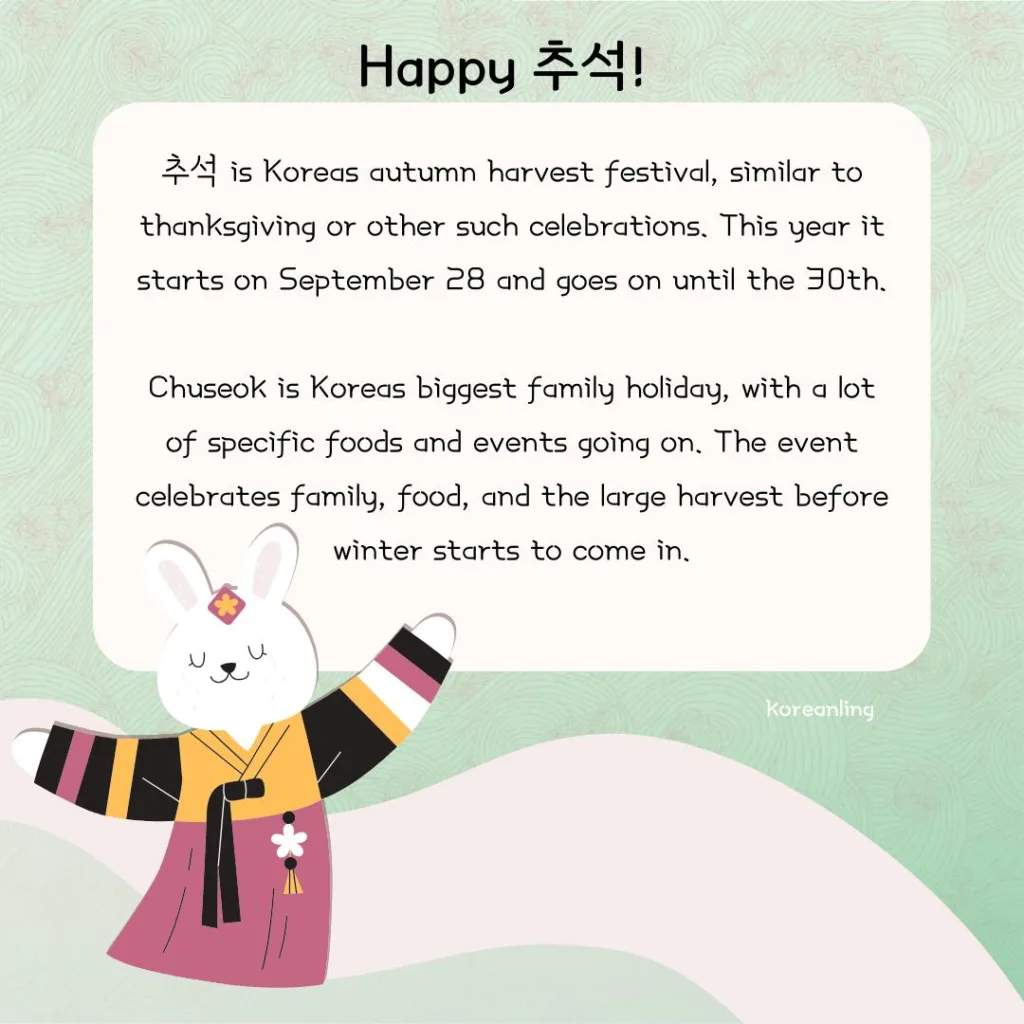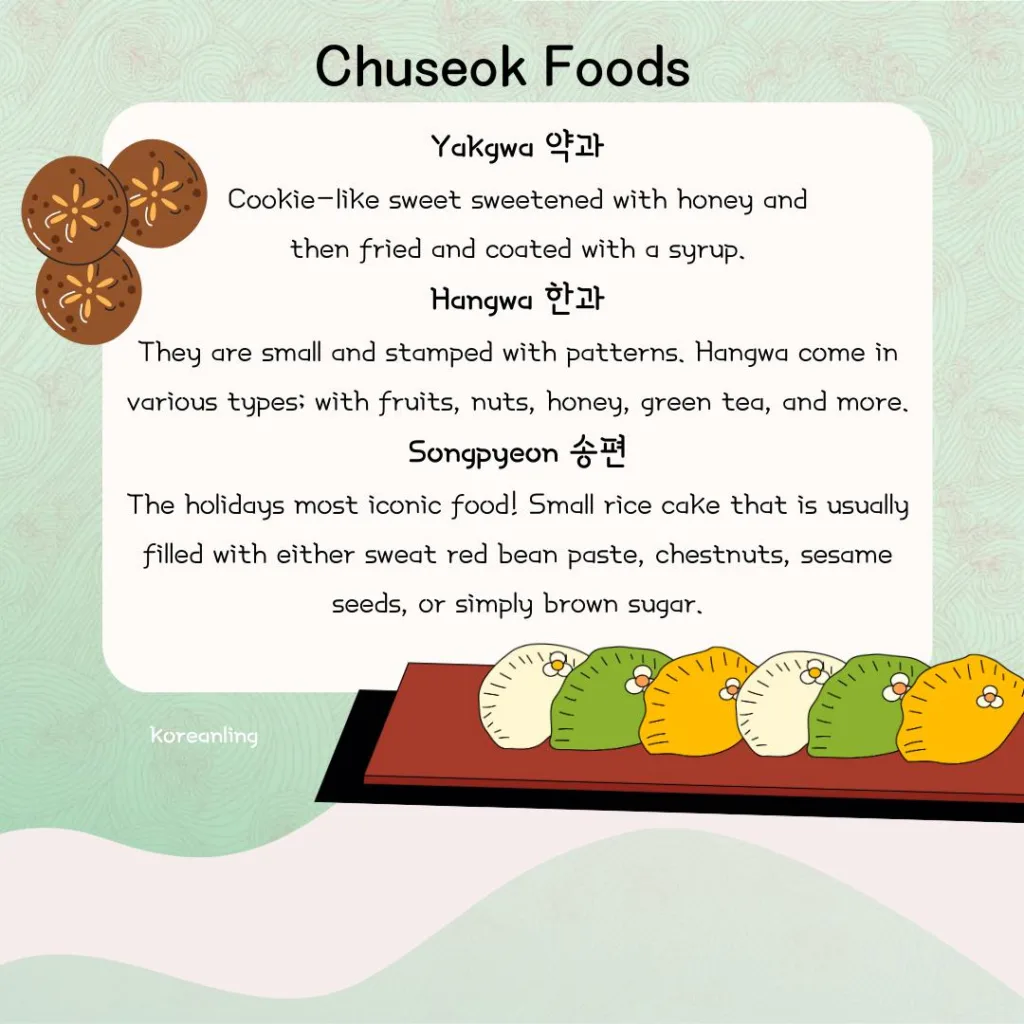추석 also known as 한가위, is Koreas autumn harvest festival, similar to thanksgiving or other such celebrations. It’s celebrated in both North and South Korea and lands on the 15/8 on the lunar calendar so it changes each year, but for this year it starts on September 28 and goes on until the 30th. Uniquely 추석 guarantees 3 days off; the day before, 추석 day, and day after.

Where Does Chuseok Come From?
Chuseok is an age old celebration so when it originated is a bit debated. Some think it comes from around 57 BC – 935 AD as a part of another celebration called gabae. Gabae was a month-long weaving contest between two teams and when the competition was over the winner would be treated to a feast from the losing team.
Other think that it is tied to celebrations for the harvest moon where people would offer deities and ancestors new harvests. Which means chuseok could have started off as a worship ritual.
Whichever the origins or history, chuseok has developed to be a big family event in Korea, with a lot of specific foods and events going on. The event celebrates family, food, and the large harvest before winter starts to come in.

What food is served at Chuseok?
Some common holiday foods are:
Yakgwa 약과
Yakgwa is popular traditional sweet. It can also be decorated and stylized but most commonly you’ll find it sort of shaped like a flower. This sweet is cookie-like sweetened with honey and then deep-fried and coated with a syrup.
Jeon 전
Pancakes but savory! Jeon has a simple batter and can be filled with lots of variety – green onion, kimchi, seafood, vegetables, potatoes. and more.
Saengseon Twigim 생선튀김
A simple fried fish dish. Typically a specific fish local near Korea (yellow croaker fish) was cooked for Chuseok. This fish can be served in soups, steamed dishes, or pan-fried without any additional seasonings, but it seems their population is dwindling so the real deal might be pretty pricey!

Hangwa 한과
Another colourful sweet you can see during 추석. Pictured above they are small and stamped with patterns. Hangwa come in various types; with fruits, nuts, honey, green tea, and more.
Songpyeon 송편
Songpyeon is the holidays most iconic food! It is a small rice cake that is usually filled with either sweat red bean paste, chestnuts, sesame seeds, or simply brown sugar.
Before there was more of a culture to make 송편 with family and go all out; doughs would be died naturally and made into unique shapes. There was even a common saying that said: “송편을 잘 빚으면 예쁜 딸을 낳는다” or in English: “If you shape 송편 well, you’ll have a pretty daughter”.
The tradition has died off more recently, which is a bit sad but understandable; it is a lot of time and effort to hand make many various 송편! Still it’s a major part of the holiday and family-made or not people still want the colorful snacks and treats during the holiday.

What are the traditions of Chuseok?
Visiting with Offerings Ancestors Graves:
추석 is all about family, both alive and past. Koreans usually hold a memorial service, or charye (차례), in honor of their ancestors and offer certain foods to them such as rice and fruits. Which additional food is offered changes a bit depending on region though, in Seoul salted fish and meat dishes are offered along with rice for instance.
When giving appreciation to ancestors Koreans also go to the family grave plot and sweep and clean the area. Then, they bow to their ancestors graves as a whole family which is called sungmyo (성묘).
Giving Gifts on Chuseok
People also need to celebrate their live family! 추석 gift sets are common to find around in Korea before the holiday begins in stores and supermarkets. Many gifts are very food and health focused; from having fruit, alcohol, and meat, to ginseng products, health products, and others.
Interestingly though; the fruit gifts are pretty pricey and filled with premium fresh fruits. So don’t mistake them for the fruits you normally get at the grocery store. Quality Beef is also an expensive gift to give that people really love.
What games do you play on Chuseok?
Sserium 씨름
Korean traditionally wrestling; it has a rich history and is debated to thousands of years old by scholars. People people pair up to fight wearing long cloth belts around their waists and 1 thigh. The goal is to grab the opponents’ belt and try to get them to fall/flip to the ground.
Tug of war 줄다리기
The classic game of tug of war exists in Korea too! Traditionally the Korean version was played by people to determine if there would be an abundant harvest.
Chicken fight 닭싸움
is a classic simple game you might have seen already on Korean reality shows. People go face to face holding one leg up and trying to make the other person stumble. People attack and try to throw the other off balance by hitting the opponents raised leg with their own. First to loose balance and put their leg down is out.
Go-Stop 고스톱
Also called also called Godori, or 고도리 after the winning move. A traditional Korean card game with special cards. Mostly it’s played between 2 or 3 people. The goal is to get 3 or 7 points and call out either “go” or “stop”. Calling out “go” risks your winnings to try to get more at the chance of someone else stealing your win, while “stop” ends the game and you collect your winnings. Very popular among the older generation, they can go really fast playing through games!
(Not so) Fun Fact:
추석 is the biggest holiday in Korea, so much so that traffic and flights are wild. While I haven’t experienced it myself, I have seen comments from people in Korea that leaving as early at 4am is ideal to try to beat the traffic rush of people going back home to visit family. Even that a 3 hour drive can be doubled to 6 hours or even more just by the rush!
Train tickets to other towns and cities also sell out very fast. But since most Koreans get these days off, it also means an increase of people buying tickets and planning trips out to get the most out of the days off. So reader beware; traveling during this time can be rough!



0 Comments